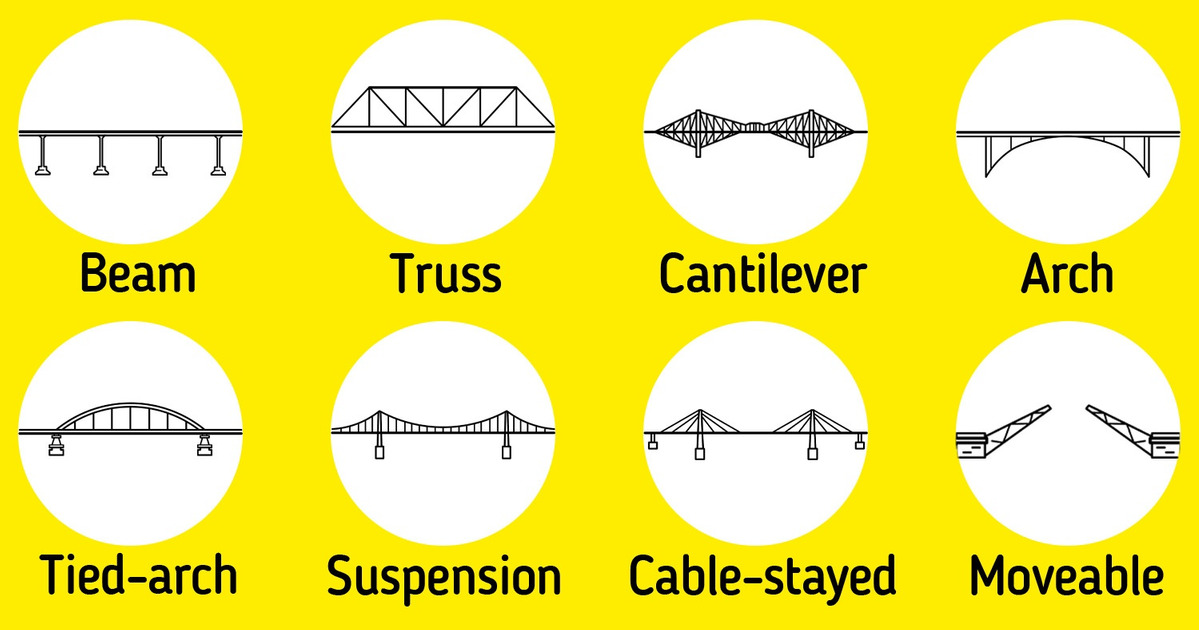A Guide on Types of Bridges

A bridge is a construction built for providing passage over an obstacle, such as a pool, valley, or complex road without blocking the way underneath. There are many types of bridges, each of which serves a certain purpose and is applied to different situations. Their construction differs depending on the function of the bridge, the materials for its construction, and the type of terrain the bridge is located on.
5-Minute Crafts is telling you about 8 widespread types of bridges.
1. Beam bridge

A beam bridge is the simplest and most popular type of bridge. It consists of large horizontal beams that cover the distance between the supports. There can be 2 such supports and the beams can form only one or several spans. In the case of the latter, the beams connect the supports in a series, forming 2 or more spans.
The earliest beam bridges were simple logs that sat across streams. Nowadays, they range from small wooden structures to large steel structures.
In general, beam bridges are used for relatively short distances because they don’t have supports built into the structure. At the same time, the farther from each other the supports are placed, the weaker the beam bridge is. As a result, they rarely have a length of more than 250 feet.
2. Truss bridge

A truss bridge is a bridge whose load-bearing superstructure is composed of a truss. This consists of a structure of connected elements, usually forming triangular units. Connected elements may become stressed due to tension, compression, or both in response to dynamic loads. The ability to distribute tension differently has led to a wide variety of truss bridge types.
Truss bridges are one of the oldest types of modern bridges. They are quite budget-friendly in construction due to the efficient use of materials. Most often, railway bridges are built from trusses.
3. Cantilever bridge

A cantilever bridge is a bridge built using cantilevers. The latter are structures that project horizontally into space, supported on only one end.
Ordinary beams can serve as cantilevers for small pedestrian bridges. However, they use trusses constructed from structural steel or box beams made of concrete in big cantilever bridges designed for car and railway traffic.
4. Arch bridge

An arch bridge is a bridge with abutments at each end shaped as a curved arch. Such bridges work by partially transferring the weight of the bridge and its loads to a horizontal thrust restrained by the abutments on either side. For example, a viaduct (a long arched bridge) can consist of a number of arches.
Ordinary arch bridges are usually designed for pedestrians. More complex structures of multiple arches can be used as road or rail bridges. In Ancient Rome, the design of arched bridges was used to build aqueducts.
5. Tied-arch bridge

Tied-arch bridges are different from regular arch bridges. The main load falls on the lower part of the structure with supports, and only the upper part of the bridge is built in the form of an arch. This allows builders to construct arch bridges with weaker foundations in places with an unstable ground.
6. Suspension bridge

The carriageway or pedestrian part of such bridges is suspended on flexible elements (like on cables), which act as a supporting structure. The earliest suspension bridges were made of ropes or vines covered with pieces of bamboo. In today’s suspension bridges, the cables hang from towers that are attached to caissons (structures for the formation of a liquid-free working chamber underwater) or cofferdams (an enclosure built within a body of water to allow the enclosed area to be pumped out) that are installed deep in the bottom of a lake, river, or sea.
7. Cable-stayed bridge

Cable-stayed bridges are very much like suspension bridges. However, the function of the main supporting structure is performed by a cable-stayed truss made of straight steel cables. The trusses are attached to small towers, or pylons, which are high stays that are installed directly on the supports. They run straight from the towers to the main part of the bridge, forming a fan-shaped pattern or a series of parallel lines.
8. Moveable bridge

A moveable bridge has a moveable part to allow the passage of boats or barges. Its advantage is lower construction costs due to the absence of high supports and long spans. The disadvantage is that traffic on the bridge stops when it’s open to traffic on the waterway.